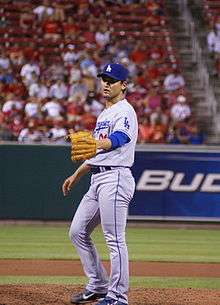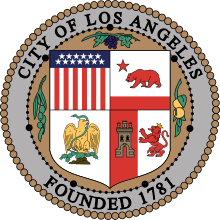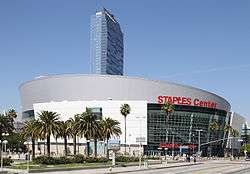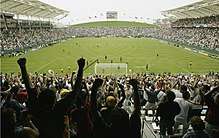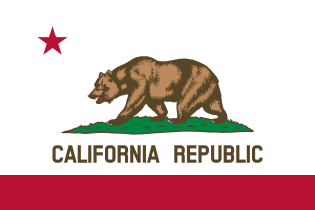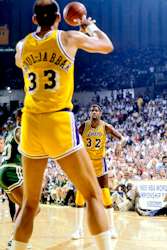Los Angeles Dodgers
The Los Angeles Dodgers are an American professional baseball team based in Los Angeles, California. The Dodgers compete in Major League Baseball (MLB) as a member club of the National League (NL) West division. Established in 1883 in the New York City borough of Brooklyn,[3][4] the team relocated to Los Angeles before the 1958 season.[5] They played four seasons at the Los Angeles Memorial Coliseum before moving to Dodger Stadium, their current home, in 1962.[6]
| Los Angeles Dodgers | |||||
|---|---|---|---|---|---|
| Established in 1883 | |||||
| Based in Los Angeles since 1958 | |||||
| |||||
| Major league affiliations | |||||
| |||||
| Current uniform | |||||
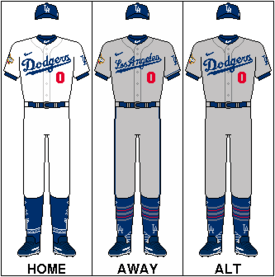 | |||||
| Retired numbers | |||||
| Colors | |||||
| |||||
| Name | |||||
| |||||
| Ballpark | |||||
| |||||
| Major league titles | |||||
| World Series titles (6) | |||||
| NL Pennants (23) | |||||
| AA Pennants (1) | 1889 | ||||
| West Division titles (18) | |||||
| Wild card berths (2) | |||||
| Front office | |||||
| Principal owner(s) | Guggenheim Baseball Management | ||||
| Manager | Dave Roberts | ||||
| President of baseball operations | Andrew Friedman | ||||

The Dodgers have won six World Series championships and twenty three National League pennants. Eleven NL MVP award winners have played for the Dodgers, winning a total of fourteen MVP Awards; eight Cy Young Award winners have also pitched for the Dodgers, winning a total of twelve Cy Young Awards. The team has eighteen Rookie of the Year Award winners, more than twice as many as the second place New York Yankees 8. The Dodgers have had four consecutive Rookies of the Year from 1979 to 1982 and five in a row from 1992 to 1996.
History
In the early 20th century, the team, then sometimes called the Brooklyn Robins after manager Wilbert Robinson, won league pennants in 1916 and 1920, losing the World Series both times, first to Boston and then Cleveland. In the 1930s, the team officially adopted the Dodgers nickname, which had been in use since the 1890s, named after the Brooklyn pedestrians who dodged the streetcars in the city.[7]
In 1941, the Dodgers captured their third National League pennant, only to lose to the New York Yankees. This marked the onset of the Dodgers–Yankees rivalry, as the Dodgers would face them in their next six World Series appearances. Led by Jackie Robinson, the first black Major League Baseball player of the modern era; and three-time National League Most Valuable Player Roy Campanella, also signed out of the Negro Leagues, the Dodgers captured their first World Series title in 1955 by defeating the Yankees for the first time, a story notably described in the 1972 book The Boys of Summer.
Following the 1957 season the team left Brooklyn. In just their second season in Los Angeles, the Dodgers won their second World Series title, beating the Chicago White Sox in six games in 1959. Spearheaded by the dominant pitching style of Sandy Koufax and Don Drysdale, the Dodgers captured three pennants in the 1960s and won two more World Series titles, sweeping the Yankees in four games in 1963, and edging the Minnesota Twins in seven in 1965. The 1963 sweep was their second victory against the Yankees, and their first against them as a Los Angeles team. The Dodgers won four more pennants in 1966, 1974, 1977 and 1978, but lost in each World Series appearance. They went on to win the World Series again in 1981, thanks in part to pitching sensation Fernando Valenzuela.
The early 1980s were affectionately dubbed "Fernandomania." In 1988, another pitching hero, Orel Hershiser, again led them to a World Series victory, aided by one of the most memorable home runs of all time, by their injured star outfielder Kirk Gibson coming off the bench to pinch hit with two outs in the bottom of the ninth inning of game 1, in his only appearance of the series. The Dodgers won the pennant in 2017 and 2018, but lost the World Series to the Houston Astros and Boston Red Sox respectively.
The Dodgers share a fierce rivalry with the San Francisco Giants, dating back to when the two franchises played in New York City. Both teams moved west for the 1958 season.[8] Both the Brooklyn/Los Angeles Dodgers and the New York/San Francisco Giants have appeared in the World Series 20 times. The Giants have won two more World Series (8); when the two teams were based in New York, the Giants won five World Series championships, and the Dodgers one. After the move to California, the Dodgers have won five World Series while the Giants have won three.
Team history
Brooklyn Dodgers
The Dodgers were founded in 1883 as the Brooklyn Atlantics, taking the name of a defunct team that had played in Brooklyn before them. The team joined the American Association in 1884 and won the AA championship in 1889 before joining the National League in 1890. They promptly won the NL Championship their first year in the League. The team was known alternatively as the Bridegrooms, Grooms, Superbas, Robins, and Trolley Dodgers before officially becoming the Brooklyn Dodgers in the 1930s.
In Brooklyn, the Dodgers won the NL pennant twelve times (1890, 1899, 1900, 1916, 1920, 1941, 1947, 1949, 1952, 1953, 1955, 1956) and the World Series in 1955. After moving to Los Angeles, the team won National League pennants in 1959, 1963, 1965, 1966, 1974, 1977, 1978, 1981, 1988, 2017, and 2018, with World Series championships in 1959, 1963, 1965, 1981 and 1988. In all, the Dodgers have appeared in 20 World Series: 9 in Brooklyn and 11 in Los Angeles.
Jackie Robinson
For most of the first half of the 20th century, no Major League Baseball team employed an African American player. Jackie Robinson became the first African American to play for a Major League Baseball team when he played his first major league game on April 15, 1947, as a member of the Brooklyn Dodgers.[9] This was mainly due to general manager Branch Rickey's efforts. The deeply religious Rickey's motivation appears to have been primarily moral, although business considerations were also a factor. Rickey was a member of The Methodist Church, the antecedent denomination to The United Methodist Church of today, which was a strong advocate for social justice and active later in the American Civil Rights Movement.[10]
This event was the harbinger of the integration of professional sports in the United States, the concomitant demise of the Negro Leagues, and is regarded as a key moment in the history of the American Civil Rights Movement. Robinson was an exceptional player, a speedy runner who sparked the team with his intensity. He was the inaugural recipient of the Rookie of the Year award, which is now named the Jackie Robinson Award in his honor. The Dodgers' willingness to integrate, when most other teams refused to, was a key factor in their 1947–1956 success. They won six pennants in those 10 years with the help of Robinson, three-time MVP Roy Campanella, Cy Young Award winner Don Newcombe, Jim Gilliam and Joe Black. Robinson would eventually go on to become the first African-American elected to the Baseball Hall of Fame in 1962.
Move to Los Angeles
Real estate investor Walter O'Malley acquired majority ownership of the Dodgers in 1950, when he bought the 25 percent share of co-owner Branch Rickey and became allied with the widow of the another equal partner, Mrs. John L. Smith. Before long, he was working to buy new land in Brooklyn to build a more accessible and profitable ballpark than the aging Ebbets Field. Beloved as it was, Ebbets Field was no longer well-served by its aging infrastructure and the Dodgers could no longer sell out the park even in the heat of a pennant race, despite largely dominating the National League from 1946 to 1957.
O'Malley wanted to build a new, state of the art stadium in Brooklyn. But City Planner Robert Moses and New York politicians refused to grant him the eminent domain authority required to build pursuant to O'Malley's plans. To put pressure on the city, during the 1955 season, O'Malley announced that the team would play seven regular season games and one exhibition game at Jersey City's Roosevelt Stadium in 1956.[11] Moses and the City considered this an empty threat, and did not believe O'Malley would go through with moving the team from New York City.
After teams began to travel to and from games by air instead of train, it became possible to include locations in the far west. Los Angeles officials attended the 1956 World Series looking to the Washington Senators to move to the West Coast. When O'Malley heard that LA was looking for a club, he sent word to the Los Angeles officials that he was interested in talking. LA offered him what New York would not: a chance to buy land suitable for building a ballpark, and own that ballpark, giving him complete control over all revenue streams. When the news came out, NYC Mayor Robert F. Wagner, Jr. and Moses made an offer to build a ballpark on the World's Fair Grounds in Queens that would be shared by the Giants and Dodgers. However, O'Malley was interested in his park only under his conditions, and the plans for a new stadium in Brooklyn seemed like a pipe dream. O'Malley decided to move the Dodgers to California, convincing Giants owner Horace Stoneham to move to San Francisco instead of Minneapolis to keep the Giants-Dodgers rivalry alive on the West Coast.[11]
The Dodgers played their final game at Ebbets Field on September 24, 1957, which the Dodgers won 2–0 over the Pittsburgh Pirates.
New York remained a one-team town with the New York Yankees until 1962, when Joan Payson founded the New York Mets and brought National League baseball back to the city. The blue background used by the Dodgers, was adopted by the Mets, honoring their New York NL forebears with a blend of Dodgers blue and Giants orange.[12]
Los Angeles Dodgers
The Dodgers were the first Major League Baseball team to ever play in Los Angeles. On April 18, 1958, the Dodgers played their first LA game, defeating the former New York and now new San Francisco Giants, 6–5, before 78,672 fans at the Los Angeles Memorial Coliseum. Catcher Roy Campanella, left partially paralyzed in an off-season accident, was never able to play in Los Angeles.
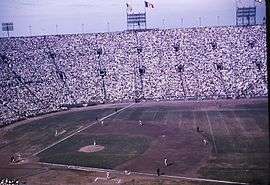
Construction on Dodger Stadium was completed in time for Opening Day 1962. With its clean, simple lines and its picturesque setting amid hills and palm trees, the ballpark quickly became an icon of the Dodgers and their new California lifestyle. O'Malley was determined that there would not be a bad seat in the house, achieving this by cantilevered grandstands that have since been widely imitated. More importantly for the team, the stadium's spacious dimensions, along with other factors, gave defense an advantage over offense and the Dodgers moved to take advantage of this by assembling a team that would excel with its pitching.
Since moving to Los Angeles, the Dodgers have won 11 more National League Championships and five World Series rings.[13]
Other historical notes
Historical records and firsts
- First baseball team to win championships in different leagues in consecutive years (1889–1890)
- First television broadcast (1939)
- First use of batting helmets (1941)
- First MLB team to employ and start an African-American player in the 20th century (Jackie Robinson, 1947)
- First MLB team to have numbers on the front of their uniforms (1952)
- First West Coast team (1958) – along with the San Francisco Giants
- First Western team to win a World Series (1959)
- First MLB team to allow a female sports journalist into a locker room (Anita Martini, 1974)
- Largest home-opener attendance: 78,672 (1958) (since broken by the Colorado Rockies in 1993)
- Largest single game attendance: 93,103 (1959) and 115,300 (2008) *World Record
- First MLB team to open an office in Asia (1998)
- Longest MLB record for home start going 13–0 (2009)
- North American record for the buying of a sports team ($2 billion, 2012)
- Most recent MLB team with the most no-hitters (26)
- First MLB team to employ a female lead trainer (Sue Falsone, 2012)
Origin of the nickname
The Dodgers' official history reports that the term "Trolley Dodgers" was attached to the Brooklyn ballclub due to the complex maze of trolley cars that weaved its way through the borough of Brooklyn.[14]
In 1892, the city of Brooklyn (Brooklyn was an independent city until annexed by New York City in 1898) began replacing its slow-moving, horse-drawn trolley lines with the faster, more powerful electric trolley lines.[15] Within less than three years, by the end of 1895, electric trolley accidents in Brooklyn had resulted in more than 130 deaths and maimed well over 500 people.[16] Brooklyn's high profile, the significant number of widely reported accidents, and a trolley strike in early 1895, combined to create a strong association in the public's mind between Brooklyn and trolley dodging.[15]
Sportswriters started using the name "Trolley Dodgers" to refer to the Brooklyn team early in the 1895 season.[17] The name was shortened to, on occasion, the "Brooklyn Dodgers" as early as 1898.[18]
Sportswriters in the early 20th century began referring to the Dodgers as the "Bums", in reference to the team's fans and possibly because of the "street character" nature of Jack Dawkins, the "Artful Dodger" in Charles Dickens' Oliver Twist. Newspaper cartoonist Willard Mullin used a drawing of famous clown Emmett Kelly to depict "Dem Bums": the team would later use "Weary Willie" in promotional images, and Kelly himself was a club mascot during the 1950s.
Other team names used by the franchise were the Atlantics, Grays, Grooms, Bridegrooms, Superbas and Robins. All of these nicknames were used by fans and sportswriters to describe the team, but not in any official capacity. The team's legal name was the Brooklyn Base Ball Club.[19] However, the Trolley Dodger nickname was used throughout this period, simultaneously with these other nicknames, by fans and sportswriters of the day. The team did not use the name in any formal sense until 1932, when the word "Dodgers" appeared on team jerseys.[3] The "conclusive shift" came in 1933, when both home and road jerseys for the team bore the name "Dodgers".[4]
Examples of how the many popularized names of the team were used are available from newspaper articles before 1932. A New York Times article describing a game in 1916 starts out: "Jimmy Callahan, pilot of the Pirates, did his best to wreck the hopes the Dodgers have of gaining the National League pennant", but then goes on to comment: "the only thing that saved the Superbas from being toppled from first place was that the Phillies lost one of the two games played".[20] What is interesting about the use of these two nicknames is that most baseball statistics sites and baseball historians generally now refer to the pennant-winning 1916 Brooklyn team as the Robins. A 1918 New York Times article uses the nickname in its title: "Buccaneers Take Last From Robins", but the subtitle of the article reads: "Subdue The Superbas By 11 To 4, Making Series An Even Break".[21]
Another example of the use of the many nicknames is found on the program issued at Ebbets Field for the 1920 World Series, which identifies the matchup in the series as "Dodgers vs. Indians" despite the fact that the Robins nickname had been in consistent use for around six years.[22] The "Robins" nickname was derived from the name of their Hall of Fame manager, Wilbert Robinson, who led the team from 1914 to 1931.[23]
Uniforms
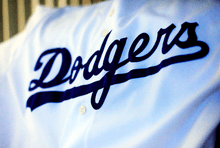
The Dodgers' uniform has remained relatively unchanged since the 1930s. The home jersey is white with "Dodgers" written in script across the chest in royal. The road jersey is gray with "Los Angeles" written in script across the chest in royal. The word "Dodgers" was first used on the front of the team's home jersey in 1933; the uniform was then white with red pinstripes and a stylized "B" on the left shoulder.[24] The Dodgers also wore green outlined uniforms and green caps throughout the 1937 season but reverted to blue the following year.
The current design was created in 1939, and has remained the same ever since with only cosmetic changes. Originally intended for the 1951 World Series for which the ballclub failed to qualify, red numbers under the "Dodgers" script were added to the home uniform in 1952.[25] The road jersey also has a red uniform number under the script. When the franchise moved from Brooklyn to Los Angeles, the city name on the road jersey changed, and the stylized "B" was replaced with the interlocking "LA" on the caps in 1958. In 1970, the Dodgers removed the city name from the road jerseys and had "Dodgers" on both the home and away uniforms. The city script returned to the road jerseys in 1999, and the tradition-rich Dodgers flirted with an alternate uniform for the first time since 1944 (when all-blue satin uniforms were introduced). These 1999 alternate jerseys had a royal top with the "Dodgers" script in white across the chest, and the red number on the front. These were worn with white pants and a new cap with silver brim, top button and Dodger logo. These alternates proved unpopular and the team abandoned them after only one season. In 2014, the Dodgers introduced an alternate road jersey: a gray version with the "Dodgers" script instead of the city name.[26] In 2018, the Dodgers wore their 60th anniversary patch to honor the 60 years of being in Los Angeles.[27][28]
 Los Angeles Dodgers Script on Dodger Blue
Los Angeles Dodgers Script on Dodger Blue
Asian players
The Dodgers have been groundbreaking in their signing of players from Asia; mainly Japan, South Korea, and Taiwan. Former owner Peter O'Malley began reaching out in 1980 by starting clinics in China and South Korea, building baseball fields in two Chinese cities, and in 1998 becoming the first major league team to open an office in Asia. The Dodgers were the second team to start a Japanese player in recent history, pitcher Hideo Nomo, the first team to start a South Korean player, pitcher Chan Ho Park, and the first Taiwanese player, Chin-Feng Chen. In addition, they were the first team to send out three Asian pitchers, from different Asian countries, in one game: Park, Hong-Chih Kuo of Taiwan, and Takashi Saito of Japan. In the 2008 season, the Dodgers had the most Asian players on its roster of any major league team with five. They included Japanese pitchers Takashi Saito and Hiroki Kuroda; South Korean pitcher Chan Ho Park; and Taiwanese pitcher Hong-Chih Kuo and infielder Chin-Lung Hu. In 2005, the Dodgers' Hee Seop Choi became the first Asian player to compete in the Home Run Derby.[29] For the 2013 season, the Dodgers signed starting pitcher Hyun-Jin Ryu with a six-year, $36 million contract, after posting a bid of nearly $27 million to acquire him from the KBO's Hanhwa Eagles. For the 2016 season, the Dodgers signed starting pitcher Kenta Maeda with an eight-year, $25 million contract, after posting a bid of $20 million to acquire him from the NPB's Hiroshima Toyo Carp.
Rivalries
The Dodgers' rivalry with the San Francisco Giants dates back to the 19th century, when the two teams were based in New York; the rivalry with the New York Yankees took place when the Dodgers were based in New York, but was revived with their East Coast/West Coast World Series battles in 1963, 1977, 1978, and 1981. The Dodgers rivalry with the Philadelphia Phillies also dates back to their days in New York, but was most fierce during the 1970s, 1980s, and 2000s. The Dodgers also had a heated rivalry with the Cincinnati Reds during the 1970s, 1980s and early 1990s. The rivalry with the Los Angeles Angels and the San Diego Padres dates back to the Angels' and Padres' respective inaugural seasons (Angels in 1961, Padres in 1969). Regional proximity is behind the rivalries with both the Angels and the Padres.
San Francisco Giants
The Dodgers–Giants rivalry is one of the longest-standing rivalries in U.S. baseball.[30][31]
The feud between the Dodgers and the San Francisco Giants began in the late 19th century when both clubs were based in New York City, with the Dodgers playing in Brooklyn and the Giants playing at the Polo Grounds in Manhattan. After the 1957 season, Dodgers owner Walter O'Malley moved the team to Los Angeles for financial and other reasons.[32] Along the way, he managed to convince Giants owner Horace Stoneham—who was considering moving his team to Minnesota—to preserve the rivalry by bringing his team to California as well.[32] New York baseball fans were stunned and heartbroken by the move.[32][33] Given that the cities of Los Angeles and San Francisco have been bitter rivals in economic, cultural, and political arenas for over a century and a half, the new venue in California became fertile ground for its transplantation.
Each team's ability to endure for over a century while moving across an entire continent, as well as the rivalry's leap from a cross-city to a cross-state engagement, have led to the rivalry being considered one of the greatest in American sports history.[34][35][36]
Unlike many other historic baseball match-ups in which one team remains dominant for most of their history, the Dodgers–Giants rivalry has exhibited a persistent balance in the respective successes of the two teams. While the Giants have more wins in franchise history, the Dodgers and Giants are tied for most National League Pennants at 23, though the Giants have won eight World Series titles, while the Dodgers have won six. The 2010 World Series was the Giants' first championship since moving to California, while the Dodgers had won five World Series titles since their move, their last title coming in the 1988 World Series.[37][38]
Los Angeles Angels
This rivalry refers to a series of games played with the Los Angeles Angels.[39] The Freeway Series takes its name from the massive freeway system in the greater Los Angeles metropolitan area, the home of both teams; one could travel from one team's stadium to the other simply by traveling along Interstate 5. The term is akin to Subway Series which refers to meetings between New York City baseball teams.[40] The term "Freeway Series" also inspired the official name of the region's NHL rivalry: the Freeway Face-Off.
Animosity between the team's fanbases grew stronger in 2005, when the Angel's new team owner Arte Moreno changed the name of his ball club from the 'Anaheim Angels', to the 'Los Angeles Angels of Anaheim'.[41] Since the city of Anaheim is located roughly 30 miles from Downtown Los Angeles, the Angels franchise was ridiculed throughout the league for the contradictory nature surrounding the name, especially by Dodgers owner Frank McCourt, who filed a formal complaint to commissioner Bud Selig.[42] Once the complaint was denied, McCourt devised a t-shirt mocking the crosstown rivals reading 'The Los Angeles Dodgers of Los Angeles', which remains popular amongst the fanbase to this day.[43]
Historical rivalry
New York Yankees
The Dodgers–Yankees rivalry is one of the most well-known rivalries in Major League Baseball.[44] The two teams have met eleven times in the World Series, more times than any other pair from the American and National Leagues.[44] The initial significance was embodied in the two teams' proximity in New York City, when the Dodgers initially played in Brooklyn. After the Dodgers moved to Los Angeles in 1958, the rivalry retained its significance as the two teams represented the dominant cities on each coast of the United States, and since the 1980s, the two largest cities in the United States.
Although the rivalry's significance arose from the two teams' numerous World Series meetings,[44] the Yankees and Dodgers have not met in the World Series since 1981.[44] They would not play each other in a non-exhibition game until 2004, when they played a three-game interleague series.[44] Their last meeting was in August 2019, when the Yankees won two out of three games in Los Angeles.[45]
Fan support

The Dodgers have a loyal fanbase, evidenced by the fact that the Dodgers were the first MLB team to attract more than 3 million fans in a season (in 1978), and accomplished that feat six more times before any other franchise did it once.[46] The Dodgers drew at least 3 million fans for 15 consecutive seasons from 1996 to 2010, the longest such streak among all MLB teams.[46] On July 3, 2007, Dodgers management announced that total franchise attendance, dating back to 1901, had reached 175 million, a record for all professional sports.[47] In 2007, the Dodgers set a franchise record for single-season attendance, attracting over 3.8 million fans.[48] In 2009, the Dodgers led the MLB in total attendance.[49] The Dodger baseball cap is consistently in the top three in sales.[50] During the 2011–2012 season, Frank McCourt, the owner of the Dodgers at that time, was going through a rough divorce with his wife over who should be the owner of the Dodger team. Instead, Frank McCourt paid $131 million to his wife as part of the divorce settlement.[51] As a result, the team payroll was financially low for a big-budget team crippling the Dodgers in the free agent market. Collectively, the team performance waned due to the distracting drama in the front office which resulted in low attendance numbers.[52]
Given the team's proximity to Hollywood, numerous celebrities can often be seen attending home games at Dodger Stadium. Celebrities such as co-owner Magic Johnson, Mary Hart, Larry King, Tiger Woods, Alyssa Milano, and Shia LaBeouf are known to sit at field box seats behind home plate where they sign autographs for fellow Dodger fans. Actor Bryan Cranston is a lifelong Dodger fan.
The Dodgers set the world record for the largest attendance for a single baseball game during an exhibition game against the Boston Red Sox on March 28, 2008, at the Los Angeles Memorial Coliseum in honor of the Dodgers' 50th anniversary, with 115,300 fans in attendance. All proceeds from the game were donated to the official charity beneficiary of the Dodgers, ThinkCure!, which supports cancer research at Children's Hospital Los Angeles and City of Hope. Primarily, Dodgers fans are from their own location in southern California and also parts of southern Nevada. However, there are also strong pockets of supporters in Mexico and throughout Asia, and their away games throughout the US will usually attract substantial numbers of expats and traveling fans.
Radio and television
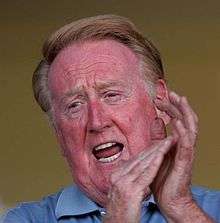
Vin Scully called Dodgers games from 1950 to 2016.[53] His longtime partners were Jerry Doggett (1956–1987) and Ross Porter (1977–2004).[53] In 1976, he was selected by Dodgers fans as the Most Memorable Personality (on the field or off) in the team's history. He is also a recipient of the Baseball Hall of Fame's Ford C. Frick Award for broadcasters (inducted in 1982). Unlike the modern style in which multiple sportscasters have an on-air conversation (usually with one functioning as play-by-play announcer and the other[s] as color commentator), Scully, Doggett and Porter generally called games solo, trading with each other inning-by-inning. In the 1980s and 1990s, Scully would call the entire radio broadcast except for the third and seventh inning, allowing the other Dodger commentators to broadcast an inning.
When Doggett retired after the 1987 season, he was replaced by Hall-of-Fame Dodgers pitcher Don Drysdale, who previously broadcast games for the California Angels and Chicago White Sox.[53] Drysdale died in his hotel room following a heart attack before a game in Montreal in 1993. This was a difficult broadcast for Scully and Porter who could not mention it on-air until Drysdale's family had been notified and the official announcement made.[54] He was replaced by former Dodgers outfielder Rick Monday.[53] Porter's tenure ended after the 2004 season, after which the format of play-by-play announcers and color commentators was installed, led by Monday and newcomer Charley Steiner.[53] Scully, however, continued to announce solo.
Scully called roughly 100 games per season (all home games and road games in California and Arizona)[55] for both flagship radio station KLAC and on television for SportsNet LA. Scully was simulcast for the first three innings of each of his appearances, then announced only for the TV audience. If Scully was calling the game, Steiner took over play-by-play on radio beginning with the fourth inning, with Monday as color commentator.[55] If Scully was not calling the game, Steiner and Orel Hershiser called the entire game on television while Monday and Kevin Kennedy did the same on radio. In the event the Dodgers were in post-season play, Scully called the first three and last three innings of the radio broadcast alone and Steiner and Monday handled the middle innings.[56] Vin Scully retired from calling games in 2016. His tenure with the Dodgers was the longest with any single sports team at 67 years. Youthful announcer Joe Davis was selected in 2017 by Dodgers management to handle play by play on television with Orel Hershiser as his colorman.
The Dodgers also broadcast on radio in Spanish, and the play-by-play is voiced by another Frick Award winner, Jaime Jarrín, who has been with the Dodgers since 1959. The color analyst for some games is former Dodger pitcher Fernando Valenzuela, for whom Jarrin once translated post-game interviews. The Spanish-language radio flagship station is KTNQ.
Management
- Owner: Guggenheim Baseball Management
- Chairman/Controlling Partner: Mark Walter
- Partner: Earvin "Magic" Johnson
- Partner: Peter Guber
- Partner: Todd Boehly
- Partner: Billie Jean King
- Partner: Ilana Kloss
- Partner: Robert "Bobby" Patton, Jr.
- Partner: Alan Smolinisky
- Partner: Robert L. Plummer
- President/chief executive officer: Stan Kasten
- President of Baseball Operations: Andrew Friedman
- General Manager:
Achievements
Baseball Hall of Famers
| Los Angeles Dodgers Hall of Famers | |||||||||
|---|---|---|---|---|---|---|---|---|---|
| Affiliation according to the National Baseball Hall of Fame and Museum | |||||||||
|
Ford C. Frick Award recipients
| Los Angeles Dodgers Ford C. Frick Award recipients | |||||||||
|---|---|---|---|---|---|---|---|---|---|
| Affiliation according to the National Baseball Hall of Fame and Museum | |||||||||
|
Team captains
- Leo Durocher 1938–1941
- Pee Wee Reese 1950–1958
- Duke Snider 1962
- Maury Wills 1963–1966
- Davey Lopes 1978–1979
Retired numbers
|

Koufax, Campanella, and Robinson were the first Dodgers to have their numbers retired, in a ceremony at Dodger Stadium on June 4, 1972. This was the year in which Koufax was inducted into the Baseball Hall of Fame; Robinson and Campanella were already Hall-of-Famers.
Alston's number was retired in the year following his retirement as the Dodgers manager, six years before he was inducted into the Hall of Fame.
Gilliam died suddenly in 1978 after a 28-year career with the Dodgers organization. The Dodgers retired his number two days after his death, prior to Game 1 of the 1978 World Series. As of 2018, he is the only non-Hall-of-Famer to have his number retired by the Dodgers (Alston's number was retired before he was elected to the Hall of Fame).
Beginning in 1980, the Dodgers have retired the numbers of longtime Dodgers (Snider, Reese, Drysdale, Lasorda, and Sutton) during the seasons in which each was inducted into the Hall of Fame.
In 1997, 50 years after he broke the color barrier and 25 years after the Dodgers retired his number, Robinson's No. 42 was retired throughout Major League Baseball. Robinson is the only major league baseball player to have this honor bestowed upon him. Starting in the 2007 season, Jackie Robinson Day (April 15, commemorating Opening Day of Robinson's rookie season of 1947) has featured many or all players and coaches wearing the number 42 as a tribute to Robinson.
The Dodgers have not issued the number 34 since the departure of Fernando Valenzuela in 1991, although it has not been officially retired.
Awards
Team records
Personnel
Current roster
Los Angeles Dodgers roster | ||||||
|---|---|---|---|---|---|---|
| Active roster | Player pool | Coaches/Other | ||||
|
Pitchers
Bullpen
Closer |
Catchers
Infielders
Outfielders
|
Pitchers
Catchers
Infielders
Outfielders
|
Manager
Coaches
45-day injured list
COVID-19 related list
Restricted list
28 active, 32 player pool
| |||
Presidents
- Charlie Byrne (1883–1897)
- Charles Ebbets (1898–1925)
- Edward McKeever (1925, interim)
- Wilbert Robinson (1925–1929)
- Frank B. York (1930–1932)
- Stephen McKeever (1933–1938)
- Larry MacPhail (1939–1942)
- Branch Rickey (1943–1950)
- Walter O'Malley (1950–1970)
- Peter O'Malley (1970–1997)
- Bob Graziano (1998–2004)
- Jamie McCourt (2004–2009)
- Dennis Mannion (2009–2010)
- Stan Kasten (2012–present)
Managers
Since 1884, the Dodgers have used a total of 31 Managers, the most current being Dave Roberts, who was appointed following the 2015 postseason, after the departure of Don Mattingly.
Over the nearly 43 years from 1954 to mid-1996, the Dodgers employed only two managers, Walter Alston and Tommy Lasorda, both of whom are in the Hall of Fame. During this entire time period of extraordinary stability, the Dodgers were family owned by Walter O'Malley and then his son Peter O'Malley. It was during this era that the Dodgers won 11 of their 21 pennants, and all six of their World Series championships.
The managers of the Los Angeles Dodgers (1958–present) are as follows:
- Walter Alston (1958–1976) (in Brooklyn since 1954)
- Tommy Lasorda (1976–1996)
- Bill Russell (1996–1998)
- Glenn Hoffman (1998)
- Davey Johnson (1999–2000)
- Jim Tracy (2001–2005)
- Grady Little (2006–2007)
- Joe Torre (2008–2010)
- Don Mattingly (2011–2015)
- Dave Roberts (2016–present)
General Managers
- Larry MacPhail (1938–1942)
- Branch Rickey (1943–1950)
- Buzzie Bavasi (1950–1968)
- Fresco Thompson (1968)
- Al Campanis (1968–1987)
- Fred Claire (1987–1998)
- Tommy Lasorda (1998)
- Kevin Malone (1999–2001)
- Dave Wallace (2001)
- Dan Evans (2001–2004)
- Paul DePodesta (2004–2005)
- Ned Colletti (2005–2014)
- Farhan Zaidi (2014–2018)
- Vacant (2019–present)
Public address announcers/organists
During their time in Brooklyn, stadium organist Gladys Goodding became so well known that fans would joke that she was "the only Dodger who played every game without an error".
From the Dodgers' move to Los Angeles from Brooklyn in 1958, the Dodgers employed a handful of well-known public address announcers; the most famous of which was John Ramsey, who served as the PA voice of the Dodgers from 1958 until his retirement in 1982; he was also well known for announcing at other venerable Los Angeles venues, including the Los Angeles Memorial Coliseum and Sports Arena, and the Forum. Ramsey died in 1990.
From 1958 to 1982, Doug Moore, Philip Petty, and Dennis Packer served as back-up voices for John Ramsey for the Dodgers, California Angels, Los Angeles Chargers, USC football and Los Angeles Rams. Packer was Ramsey's primary backup for the Los Angeles Lakers and Los Angeles Kings until Ramsey's retirement from the Forum in 1978. Thereafter, Packer became the public address announcer for the Lakers, Kings, indoor soccer and indoor tennis events at the Forum.
Nick Nickson, a radio broadcaster for the Los Angeles Kings, replaced John Ramsey as the Dodger Stadium public address announcer in 1983 and served in that capacity through the 1989 season to work with the Kings full-time.
Dennis Packer and Pete Arbogast were emulators of John Ramsey, using the same stentorian style of announcing Ramsey was famous for. Packer and Arbogast shared the stadium announcing chores for the 1994 FIFA World Cup matches at the Rose Bowl. Arbogast won the Dodgers job on the day that Ramsey died on January 25, 1990, by doing a verbatim imitation of Ramsey's opening and closing remarks that were standard at each game. His replacement, in 1994 was Mike Carlucci, who remained as the Dodgers' PA voice announcer until he resigned in 2002 to concentrate on his voiceover and acting career along with his Olympics announcing duties.
From 2003 to 2014, the Dodgers public address announcer was Eric Smith, who also announces for the Los Angeles Clippers and USC Trojans.[58]
On April 3, 2015 the Dodgers announced that former radio broadcaster Todd Leitz was hired to become their new public address announcer. Leitz was an anchor and news reporter in Los Angeles at KNX 1070 AM for 10 years, and a news reporter at KABC 790 for two years.[59]
From 1988 to 2015, Nancy Bea enjoyed popularity behind the Dodger Stadium keyboard similar to Gladys Goodding. Since retirement in 2015, Beal's replacement and current organist is Dieter Ruehle, who also plays at Staples Center for Los Angeles Kings games.
Other
Vin Scully is permanently honored in the Baseball Hall of Fame's "Scribes & Mikemen" exhibit as a result of winning the Ford C. Frick Award in 1982. Frick Award recipients are not official members of the Hall.
Sue Falsone, was the first female physical therapist in Major League baseball, and from 2012 to 2013, was the first female head athletic trainer.
Minor league affiliations
The Los Angeles Dodgers farm system consists of nine minor league affiliates.[60]
| Level | Team | League | Location |
|---|---|---|---|
| Triple-A | Oklahoma City Dodgers | Pacific Coast League | Oklahoma City, Oklahoma |
| Double-A | Tulsa Drillers | Texas League | Tulsa, Oklahoma |
| Class A-Advanced | Rancho Cucamonga Quakes | California League | Rancho Cucamonga, California |
| Class A | Great Lakes Loons | Midwest League | Midland, Michigan |
| Rookie | Ogden Raptors | Pioneer League | Ogden, Utah |
| AZL Dodgers Mota | Arizona League | Phoenix, Arizona | |
| AZL Dodgers Lasorda | |||
| DSL Dodgers Bautista | Dominican Summer League | Santo Domingo, Distrito Nacional | |
| DSL Dodgers Shoemaker |
Minor league rosters
See also
References
- Castrovince, Anthony (May 17, 2019). "Players poll: Who has MLB's best uniforms?". MLB.com. MLB Advanced Media. Retrieved June 22, 2019.
The billowy script Dodgers in an alluring angle and a blue so distinctive that it has come to bear the name of the team. The red numbers that pop, as if dropped straight from the heart to the left upper abdomen. The interlocking LA on the sleeve, matching the simple-but-distinctive blue caps. All of these elements combine to make the Dodgers' home white somehow shine a little bit brighter. It is a timeless, trimless look, baseball's accouterment answer to the American flag.
- "Major League Baseball And The Los Angeles Dodgers Unveil The Official Logo Of The 2020 All-Star Game Presented By Mastercard". MLB.com (Press release). MLB Advanced Media. July 23, 2019. Retrieved July 23, 2019.
The official logo of the 2020 MLB All-Star Game celebrates the golden age of Hollywood. Within the logo, the words 'All-Star Game' appear epic as in a dynamic film scroll. The golden logo is contained in the signature hexagon shape found throughout Dodger Stadium. The Club's iconic Dodger Blue creates the logo's dimension, while the star features a splash of red reminiscent of the Dodgers' classic jerseys. Stylistically these icons and colors create a unique Los Angeles theme to MLB's Midsummer Classic.
- "Dressed to the Nines uniform database". National Baseball Hall of Fame. Retrieved October 8, 2008.
- Bernado, Leonard; Weiss, Jennifer (2006). Brooklyn By Name: From Bedford-Stuyvesant to Flatbush Avenue, And From Ebbetts Field To Williamsburg. New York: New York University Press. p. 81.
- "Franchise Timeline - 1950s". Dodgers.com. MLB Advanced Media. Retrieved June 14, 2018.
- "Ballparks". Dodgers.com. MLB Advanced Media. Retrieved April 15, 2019.
- Chase, Chris (February 9, 2015). "Strange-but-true origin stories of 19 sports team names". USA Today. Retrieved October 25, 2015.
- "Baseball owners allow Dodgers and Giants to move". History (U.S. TV network). August 21, 2018.
- Mitrovich, George. "As I See It: Happy birthday, Jack Roosevelt Robinson". telegram.com. Retrieved February 21, 2019.
- "Branch Rickey, 83, Dies in Missouri". The New York Times. Retrieved December 29, 2008.
- "Brooklyn Dodgers (1890-1957)". www.sportsecyclopedia.com.
- "Mets Timeline | Mets.com: History". MLB.com. Retrieved January 27, 2013.
- "WATCH: Dodgers Receive 2018 NLCS Rings During Clubhouse Ceremony". Dodger Blue. March 31, 2019.
- "Franchise Timeline - 1890s". Dodgers.com. MLB Advanced Media. Retrieved June 14, 2018.
- Brown, Peter Jensen (April 7, 2014). "The Grim Reality of the "Trolley Dodgers"". Early Sports and Pop-Culture History Blog. Retrieved April 9, 2014.
- The Christian Work. 60: 10. January 2, 1896. Missing or empty
|title=(help) - "Notes of the Diamond". The Scranton Tribune. May 11, 1895.
- "Current Sporting Notes". Evening Star (Washington DC). April 25, 1898. Retrieved April 9, 2014.
- "Brooklyn Ball Parks". BrooklynBallParks.com. Retrieved October 9, 2008.
- "Buccaneers Rout Sleepy Superbas" (PDF). New York Times. September 14, 1916. Retrieved October 8, 2008.
- "Buccaneers Take Last From Robins" (PDF). New York Times. May 19, 1918. Retrieved October 8, 2008.
- "File:1920 World Series program.jpg – Wikimedia Commons". Commons.wikimedia.org. Retrieved March 29, 2012.
- "Wilbert Robinson". Baseball-statistics.com. August 8, 1934. Retrieved March 29, 2012.
- "Dodgers Uniforms & Logos". Dodgers.com. MLB Advanced Media. Retrieved October 21, 2018.
- Ruhl, Oscar. "From the Ruhl Book" (column), The Sporting News, April 30, 1952. Retrieved August 6, 2019
- Nowak, Joey (January 30, 2014). "Dodgers to wear road jersey featuring team name". Dodgers.com. MLB Advanced Media. Retrieved June 14, 2018.
- Gurnick, Ken (January 23, 2018). "Dodgers celebrate 60 years of playing in LA". Dodgers.com. MLB Advanced Media. Retrieved June 14, 2018.
- "Dodgers unveil 60th anniversary logo". Park Labrea News/ Beverly Press. January 25, 2018. Retrieved March 26, 2018.
- Baxter, Kevin (April 16, 2008). "Dodgers lead the league in Asian players". Los Angeles Times. Archived from the original on April 21, 2008. Retrieved April 17, 2008.
- "Baseball's top 10 rivalries".
- "In Depth: Baseball's Most Intense Rivalries".
- Murphy, Robert (2009). After many a summer: the passing of the Giants and Dodgers and a golden age in New York baseball. New York: Sterling. ISBN 978-1-4027-6068-6.
- Sullivan, Neil J. (1987). The Dodgers move west: the transfer of the Brooklyn baseball franchise to Los Angeles. New York: Oxford University Press. ISBN 0-19-504366-9.
- "The ten greatest rivalries". ESPN. January 3, 2000.
- Caple, Jim (September 16, 2002). "Giants-Dodgers best rivalry in baseball". ESPN.
- Beard, Donald (March 30, 2005). "Giants-Dodgers Covers a Lot of Ground". The Washington Post. p. H5.
- "Los Angeles Dodgers Team History & Encyclopedia". Baseball-Reference.com. Retrieved March 20, 2019.
- "San Francisco Giants Team History & Encyclopedia". Baseball-Reference.com. Retrieved March 20, 2019.
- "Freeway Series: Angels and Dodgers have built up some history in their relationship". Orange County Register. July 5, 2018. Retrieved March 20, 2019.
- "Subway Series Definition - Sporting Charts". www.sportingcharts.com. Retrieved March 20, 2019.
- "The Absurd History of "The Los Angeles Angels of Anaheim"". The Hardball Times. Retrieved July 22, 2020.
- "McCourt No Fan of Angels' Name". Los Angeles Times. January 14, 2005. Retrieved July 22, 2020.
- "The Los Angeles Dodgers of Los Angeles Shirt is Back, but Not for the Reason you Think". Dodgers Nation. December 21, 2019. Retrieved July 22, 2020.
- Nightengale, Bob (June 25, 2010). "Oscars of interleague: Stars coming out for Yankees-Dodgers". USA Today. p. C4.
- Gonzalez, Alden (August 25, 2019). "Seven takeaways from Yankees-Dodgers weekend showdown". ESPN. Retrieved August 26, 2019.
- "Ballparks of Baseball: MLB Attendance".
- Addcox, Jayson (July 4, 2007). "Dodgers surpass attendance milestone". MLB.com. MLB Advanced Media. Archived from the original on October 14, 2007. Retrieved June 14, 2018.
- "MLB shatters attendance record". MLB.com. MLB Advanced Media. October 2, 2007. Retrieved June 14, 2018.
- "MLB Attendance – Major League Baseball Attendance – ESPN".
- "Top-Selling Caps". The New York Times.
- "Frank McCourt to pay ex-wife $131M".
- "Dodgers' 2011 home attendance: Down 627,181".
- Justice, Richard (September 24, 2016). "Dodgers pay tribute to 'national treasure' Scully". Dodgers.com. MLB Advanced Media. Retrieved June 14, 2018.
- Smith, Claire (July 7, 1993). "Dodgers' Death Brings Out the Best". New York Times. Retrieved February 26, 2009.
- Jackson, Tony (March 18, 2012). "Vin Scully trims '12 travel schedule". ESPNLosAngeles.com. Retrieved June 4, 2012.
- Pucin, Diane (December 13, 2008). "Charley Steiner will do radio only for the Dodgers". Los Angeles Dodgers. Retrieved February 12, 2009.
- "O'Malley, Walter". Baseball Hall of Fame - Hall of Famers. Retrieved February 5, 2019.
- "Orange County Register". Orange County Register. Archived from the original on October 26, 2014. Retrieved October 26, 2014.
- "Dodgers hire Leitz as new PA announcer". April 3, 2015.
- "Los Angeles Dodgers Minor League Affiliates". Baseball-Reference. Sports Reference. Retrieved May 15, 2020.
Further reading
- Red Barber, Rhubarb in the Catbird Seat
- Stanley Cohen, Dodgers! The First 100 Years
- Robert W. Creamer, Stengel: His Life and Times
- D'Agostino, Dennis; Bonnie Crosby (2007). Through a Blue Lens: The Brooklyn Dodgers Photographs of Barney Stein, 1937–1957. Triumph Books. ISBN 978-1-57243-952-8.
- Steve Delsohn, True Blue: The Dramatic History of the Los Angeles Dodgers, Told By the Men Who Lived It
- Carl Erskine and Vin Scully, Tales From the Dodger Dugout: Extra Innings
- Harvey Froemmer, New York City Baseball
- Steve Garvey, "My Bat Boy Days: Lessons I Learned from the Boys of Summer"
- Cliff Gewecke, Day by Day in Dodgers History
- Andrew Goldblatt, The Giants and the Dodgers: Four Cities, Two Teams, One Rivalry
- Richard Goldstein, Superstars and Screwballs: 100 Years of Brooklyn Baseball
- Peter Golenbock, Bums: An Oral History of the Brooklyn Dodgers
- Doris Kearns Goodwin, Wait Till Next Year: A Memoir
- Frank Graham, The Brooklyn Dodgers: An Informal History
- Orel Hershiser with Jerry B. Jenkins, Out of the Blue
- Donald Honig, The Los Angeles Dodgers: Their First quarter Century
- Roger Kahn, The Boys of Summer
- Roger Kahn, The Era 1947–1957: When the Yankees, the Giants and the Dodgers Ruled the World
- Mark Langill, The Los Angeles Dodgers
- Tommy Lasorda with David Fisher, The Artful Dodger
- Jane Leavy, Sandy Koufax: A Lefty's Legacy
- Joseph McCauley, Ebbets Field: Brooklyn's Baseball Shrine
- William McNeil, The Dodgers Encyclopedia
- Tom Meany (editor), The Artful Dodgers
- Andrew Paul Mele, A Brooklyn Dodgers Reader
- John J. Monteleone (editor), Branch Rickey's Little Blue Book
- Thomas Oliphant, Praying for Gil Hodges: A Memoir of the 1955 World Series and One Family's Love of the Brooklyn Dodgers
- David Plaut, Chasing October: The Dodgers-Giants Pennant Race of 1962
- Carl E. Prince, Brooklyn's Dodgers: The Bums, The Borough and The Best of Baseball
- Jackie Robinson, I Never Had It Made
- Gene Schoor, The Complete Dodgers Record Book
- Gene Schoor, The Pee Wee Reese Story
- Duke Snider with Bill Gilbert, The Duke of Flatbush
- Michael Shapiro, The Last Good Season: Brooklyn, The Dodgers, and Their Final Pennant Race Together
- Glen Stout, The Dodgers: 120 Years of Dodgers Baseball
- Neil J. Sullivan, The Dodgers Move West
- Jules Tygiel, Baseball's Great Experiment: Jackie Robinson and His Legacy
- John Weaver, Los Angeles: The Enormous Village, 1781–1981
External links
| Wikimedia Commons has media related to Los Angeles Dodgers. |
- Los Angeles Dodgers official website
- Los Angeles Dodgers Baseball Reference.com
- "The 1960s Dodgers: Two Parts Patience, One Part Creative Insanity" by Steve Treder, November 10, 2004. Article on the 1960s Los Angeles Dodgers in The Hardball Times.
.svg.png)

